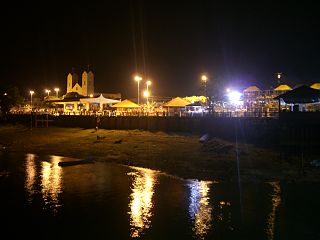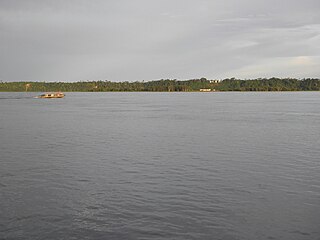
The Trans-Amazonian Highway, was introduced on September 27, 1972. It is 4,000 km long, making it the third longest highway in Brazil. It runs through the Amazon forest and the Brazilian states of Paraíba, Ceará, Piaui, Maranhão, Tocantins, Pará and Amazonas, from the proximities of Saboeiro up until the town of Lábrea.
Cruiser Linhas Aéreas was an airline based in Curitiba, Brazil. It used to operate domestic services to 10 destinations in the states of Paraná, Rondônia and Mato Grosso, as well as charter and air taxi services within Brazil. Its main base is Curitiba-Bacacheri Airport (BFH).

The Amazônia National Park was created in 1974, as a national park comprising 1,070,737 ha. It is situated in Itaituba and Trairão municipalities, Pará state, in the north region of Brazil. It is located in the watershed of the Tapajós River, about halfway between Manaus and Belém. It has expanded since its inception and now covers 8,600 square kilometres (3,300 sq mi). It is a very biodiverse habitat and contains a wide range of animals and plants. The specific objectives of the park are the preservation of various Amazonic ecosystems, through scientific, educational and recreational means.

Itaituba is a city and municipality located in the state of Pará, Brazil, and one of the most important socioeconomic centers in the western region of the State.

The Cupari River is a river that flows into the Tapajós in the Amazon rainforest of Brazil. Rio Cupari is in the eastern part of the Amazon River basin.
The Territorial Prelature of Itaituba is a Roman Catholic territorial prelature located in the city of Itaituba in the Ecclesiastical province of Santarém in Brazil.

The Cururu River is a river of Pará state in north-central Brazil. It is a right tributary of the Tapajós; the mouth is located on the eastern side of the Tapajós about 15 km (9.3 mi) north of the Juruena–Teles Pires junction.

The Jamanxim River is a river of Pará state in north-central Brazil. Originating in the Serra do Cachimbo, it is a tributary of the Tapajós, into which it flows a few kilometers upstream from Itaituba.

Trairão is a municipality in the state of Pará in the Northern region of Brazil.

Itaituba Airport is the airport serving Itaituba, Brazil.

Hemilophini is a tribe of longhorn beetles of the subfamily Lamiinae.
Itaituba is a genus of longhorn beetles of the subfamily Lamiinae, containing the following species:

Rio Novo National Park is a national park in the state of Pará, Brazil.

Itaituba II National Forest is a national forest in the state of Pará, Brazil.

Itaituba I National Forest is a national forest in the state of Pará, Brazil.

Amaná National Forest is a national forest in the state of Pará, Brazil. Most of it has been allocated for use in sustainable forestry or community forestry. Mining is allowed.
Itaituba pitanga is a species of beetle in the family Cerambycidae. It was described by Galileo and Martins in 1991. It is known from Brazil.

The Jatobá Hydroelectric Power Plant is a planned hydroelectric power plant and dam on the Tapajós river in the state of Pará, Brazil. As of 2017 the project was suspended.

The Crepori National Forest is a national forest in the state of Pará, Brazil. The forest allows sustainable use of natural resources, and mining. It is home to rich biodiversity including several endangered animal species.
Glenea miniacea is a species of beetle in the family Cerambycidae. It was described by Francis Polkinghorne Pascoe in 1867.












